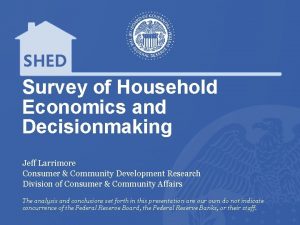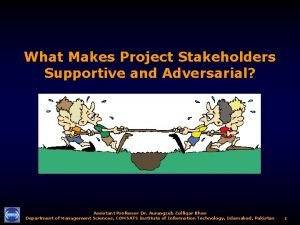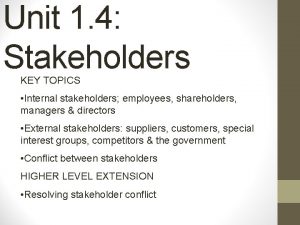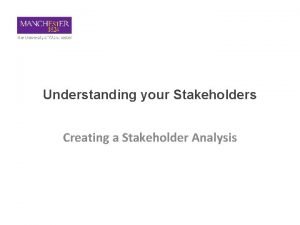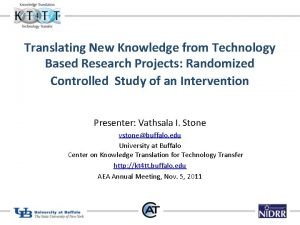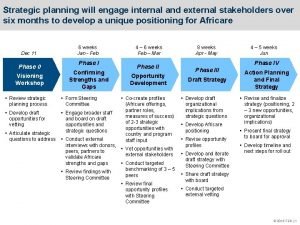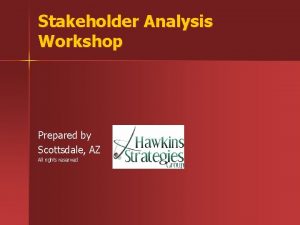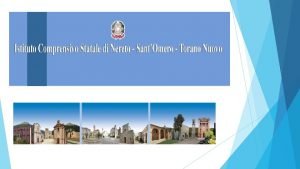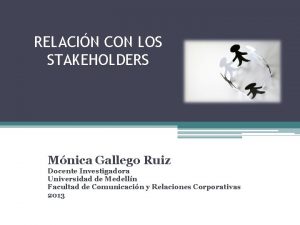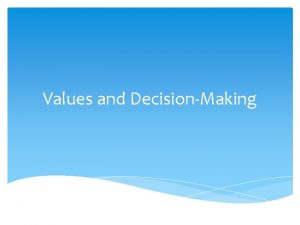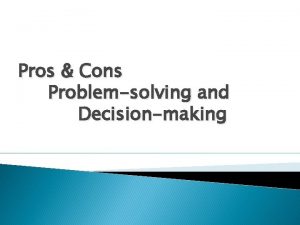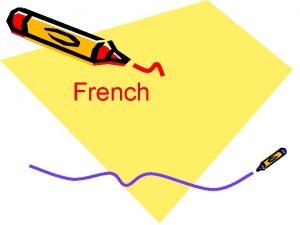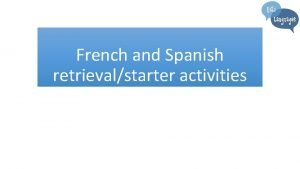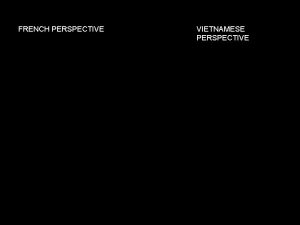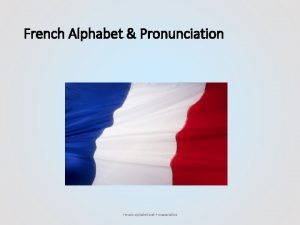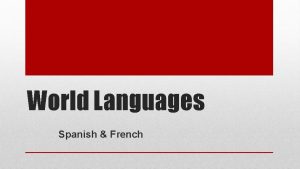Involvement of French stakeholders in the decisionmaking process















- Slides: 15

Involvement of French stakeholders in the decision-making process in the context of uncertainties NERIS Workshop 2019 3 -5 April 2019 Roskilde, Denmark Vanessa Durand, Mélanie Maître, Pascal Croüail, Sylvie Charron, Sylvain Andresz et Thierry Schneider

Objectives • CONFIDENCE WP 4 – Task 4. 2: Scenario-based Stakeholders engagement (national panel meeting: 9 European countries) • In the context of post-accident management (emergency and transition exposure situation): Identify and evaluate the uncertainties which are part of the decision-making process To analyse the implementation of the criteria proposed in the French post-accident doctrine in the decision-making process and identify the necessary data and the uncertainties that may arise and that should be considered; To evaluate what are the uncertainties which are the most important – for local stakeholders and decision makers – and how they should be taken into account in the decision-making process in order to mitigate potential adverse consequences in the longer term. More precisely, to assess if decision makers take into account : uncertainty inherent to modelling in their decisions and if they do, to which extent; other types of uncertainty in their decisions and if they do, to which extent. This project has received funding from the Euratom research and training programme 2014 -2018 under grant agreement No 662287. 2

Organisation of the French stakeholders panel 2 panel meetings: June 12, 2018 - Work on the emergency phase Understand evaluate how a decision maker is taking decisions in such a context of uncertainty. October 11, 2018 - Work on the transition phase Assess the influence of decisions made during the emergency phase over the medium to long term. How could prior knowledge of these impacts have influenced the initial decision -making? What information would have been needed to precise their decision? Focus on 2 protective actions: the evacuation and temporary relocation of populations and food restrictions (consumption / distribution) A third meeting in June 2019 - Work on guidelines and recommendations This project has received funding from the Euratom research and training programme 2014 -2018 under grant agreement No 662287. 3

Composition of the French National panel Experts of the institutional French organizations and authorities Institute for Radioprotection and Nuclear Safety (IRSN) Nuclear Safety Authority (ASN) Directorate General for Food (DGAL) Regional health agency (ARS) Several decision makers at the national and local levels of the French postemergency response system Directorate General for Competition Policy, Consumer Affairs and Fraud Control (DGCCRF) Departmental Directorate for the protection of population(DDPP) Retired Prefect and retired mayor Interdepartmental Civil Defense and Protection Service (SIDPC) Chamber of agriculture Firefighter forces Local Liaison and Information Committe This project has received funding from the Euratom research and training programme 2014 -2018 under grant agreement No 662287.

Calendar This project has received funding from the Euratom research and training programme 2014 -2018 under grant agreement No 662287. 5

Methodology Taking into account inherent uncertainties about the real situation: direct links with CONFIDENCE WP 1 to develop a basis of work for the panels meeting For the first panels meeting, WP 1 CONFIDENCE outputs allow to provide: Maps of probability of threshold exceedance, for reference levels ● Deterministic simulation: a single contour shows the impacted area ● Ensemble of simulations: Probability maps of threshold exceedance = probability that a given zone is contaminated above a given level. Maximum distance for a reference level +/- the uncertainty For the second panels meeting, WP 1 CONFIDENCE outputs allow to provide : A synthetic map of “real measurement data” from simulated airborne monitoring used to show the difference between forecast data and measurement (overlaps, zones not initially included in the decision…) For both panel meetings, preparation of maps representing the socio-economic issues of the affected territory : Agricultural production; Population density; Public buildings (school, hospitals…). This project has received funding from the Euratom research and training programme 2014 -2018 under grant agreement No 662287. 6

Case used (on Dampierre NPP sites) for the First panel meeting Probability map for threshold of 50 m. Sv on the effective dose Probability map for threshold of 37 k. Bq/m 2 on the 137 Cs deposition • Probability of threshold exceedance: computed by counting the number of simulation within the ensemble that predict a value above the given threshold at a certain point • Colored zones: areas where the simulation Probability map for threshold of 37 k. Bq/m 2 on the 137 Cs deposition with the area under cereals (vineyard, cows… also) forecasts show a risk of exceeding the threshold This project has received funding from the Euratom research and training programme 2014 -2018 under grant agreement No 662287. 7

Case used (on Dampierre NPP sites) for the Second panel meeting Emergency decision: evacuation of populations during the emergency phase (1800 people - Dampierre and Lion-en-Sullias municipalities + some people from neighboring municipalities) Relocation of population at the end of releases (airborne measurements) Emergency decision: restrictions on consumption of locally foodstuffs: 19 municipalities. Municipalities concerned by the distribution restrictions at the end of the releases: 258 municipalities This project has received funding from the Euratom research and training programme 2014 -2018 under grant agreement No 662287. 8

Results analysis and main identified issues (1/5) ~50 uncertainties for evacuation/relocation and ~30 for food restrictions Analysis of the stakeholders’ questions to identify various issues raised by the panel members regarding evacuation/relocation and food restrictions; Uncertainties have been classified depending on topics and the emergency / transition phase Classification used: S. French et al. , in The Various Meaning of Uncertainties. From these findings, various types of uncertainties have emerged and can be classified in two main categories: the external uncertainties to the decision-making process which generally speaking refer to uncertainties associated with the production of information (modelling, measurements, etc. ); the internal uncertainties to the decision-making process which are directly linked to the use of the information to take decision (reaction of decision-makers given the ambiguity, clarity of the situation, personal judgement, social reactions, economic impacts, etc. ) This project has received funding from the Euratom research and training programme 2014 -2018 under grant agreement No 662287. 9

Results analysis and main identified issues (2/5) 1/ Uncertainties associated with the production of information (external uncertainties) Stochastic, epistemological, judgmental, computational, modelling uncertainties “What is the level of reliability of the probability maps? What if the release occurs during a longer time frame? How do you consider the meteorological forecast (wind)? What is the level of reliability of the measurements? What is the level of conservatism? ” 2/ Uncertainties associated with the use of information (internal information) Uncertainties related to the decision itself – how to shape the strategy given the available information “When should we communicate about relocation? Is it when the results of the model are available or after a few days when the zoning is well established based on field measurements? ” “Should we not wait for the first map of contamination based on field measurements? ” “Should we consider other criteria (geographical, socio-economic) in addition to the radiological ones? How to put into balance these different criteria? ” “Should we make a distinction between consumption and commercialization or link both? Where to put the higher protection: on food intended for commercialization or food intended for self-consumption? Which strategy to adopt? Create an extended restriction zone to be reduced progressively according to on-the-field measurements (“from big to small” approach) or instead, a small restriction zone that could be expanded if necessary (“step by step” approach)? ” This project has received funding from the Euratom research and training programme 2014 -2018 under grant agreement No 662287. 10

Results analysis and main identified issues (3/5) 2/ Uncertainties associated with the use of information (internal information) Uncertainties related to the governance “Taking into account the “Safety Contingency Plan” at communal level, is it possible that mayors decide evacuation by themselves? Will this strategy for evacuation, decided at local level, be validated by higher authorities? Will higher institutional actors/decision-makers change this strategy and implement a new one? Will this zoning for food restrictions be agreed and validated by higher authorities? ” Uncertainties related to communication issues “Will prior communication (by social media, traditional media, etc. ) able to broadcast the “right” messages and prevent panic? Besides traditional media (TV, radio), what can be done to limit the spread of rumours and broadcast reliable information on the social media? When should we communicate about relocation? When the results of the model are available or after a few days when the zoning is well established based on field measurements? ” “What are the best messages given the circumstances? To what extend does the population understand the evacuation procedures and the doctrine? How will the messages be understood? What information is clear and concrete enough to reassure on the effectiveness of protective actions and provide support to the individuals according to their situation? ” This project has received funding from the Euratom research and training programme 2014 -2018 under grant agreement No 662287. 11

Results analysis and main identified issues (4/5) 2/ Uncertainties associated with the use of information (end) Social acceptance – behaviours and reactions “What to do if the bus drivers use their right to withdrawal? Will the military or police forces be able to contain any potential panic? What are the options at our disposal if some first responders/actors (e. g. bus drivers) use their right of withdrawal? ” “How to outreach the general population and the hosting territories in particular, and not generate stigmatization of the relocated individuals and affected territories? To what extent will the messages be understood? In particular for the individuals living outside the zoning borders? ” Economical and other side-effects uncertainties “What will be the socio-economic impacts on the affected territories? How to maintain an activity in theses territories over the long term? ” “What about the brand damage/loss for the products and for the (affected) territories? How can we evaluate the impacts? What will be the situation for the affected territories? What will be the socio-economic impacts on each production sectors (considering the added value of the sector and the actors)? What are the economic losses for each food production sectors if they are « stigmatized » ? This project has received funding from the Euratom research and training programme 2014 -2018 under grant agreement No 662287. 12

Results analysis and main identified issues (5/5) 3/ Uncertainties related to the evolution of the situation over time “What will be the evolution of the situation in the next hours? Is it possible to anticipate now the zonings at far distance from the nuclear plant that will be concerned by relocation? ” “What will be the evolution of the radiological situation? What will be the evolution of the zoning for relocation in the next months? What is the level of reliability of this evolution? ” “How to adjust the strategy for relocation (and the protective actions) according to the evolution of the radiological condition? How to link the evolution of the restrictions with the calendars of harvest and effective consumption of the products? ” 4/ What information and support of information should be produced? “What is the sociological profile of the population? What is the level of self-sufficiency of the population (consumption of the food produced in garden, harvest in forest, hunting, etc. )? What are the products that have the higher impact (dose) when it comes to ingestion? ” “What is the reliability of the boundaries proposed for the relocation zone? What will be the radiological measurements performed at the boundaries of the zoning for relocation? How to ensure that the boundaries of the zoning for relocation actually protect the individuals living nearby? ” This project has received funding from the Euratom research and training programme 2014 -2018 under grant agreement No 662287. 13

Conclusions and next steps Overall, these two meetings raised the following findings: The temporal dimension (evolution of zoning over time) is confirmed as very useful for decision-makers; The importance of diverse information, not only focused on radiological impacts, to help decision-making: geographic information, socio-economic issues of the territories, etc. ; The fact that the transition from emergency to post-accident phases is a challenging period (for all decision-makers); The decisions taken during the emergency/post-accident phases could be political and might be taken over at high levels (but on a common basis). For now, key points which come out are the need to: Improve the robustness of dosimetric and radiological data and the way this information can be provided to decision-makers by reflecting clearly the remaining uncertainties; Collect and propose contextual information related to the concerned population, the affected territory and the local situation which could help decisions-makers; Further analyse how this contextual information comes into play in the decision-making process considering the various points of view, the time evolution, etc. ; Prepare in advance messages associated with the decision to be understood by the population. Next meeting: identify lessons learned and recommendations for improving preparedness This project has received funding from the Euratom research and training programme 2014 -2018 under grant agreement No 662287. 14

Thank you for your attention! 15
 Survey of household economics and decisionmaking
Survey of household economics and decisionmaking Flossies kitten rescue
Flossies kitten rescue Adversarial stakeholders
Adversarial stakeholders Primary and secondary stakeholders
Primary and secondary stakeholders Key internal and external stakeholders
Key internal and external stakeholders Understanding your stakeholders
Understanding your stakeholders C level stakeholders
C level stakeholders Real estate stakeholders
Real estate stakeholders Stakeholders matrix
Stakeholders matrix Internal vs external stakeholders
Internal vs external stakeholders Stakeholders higher business
Stakeholders higher business Stakeholders in business
Stakeholders in business Bank stakeholders analysis
Bank stakeholders analysis How to write background of the project
How to write background of the project Stakeholders scuola
Stakeholders scuola Stakeholders
Stakeholders
